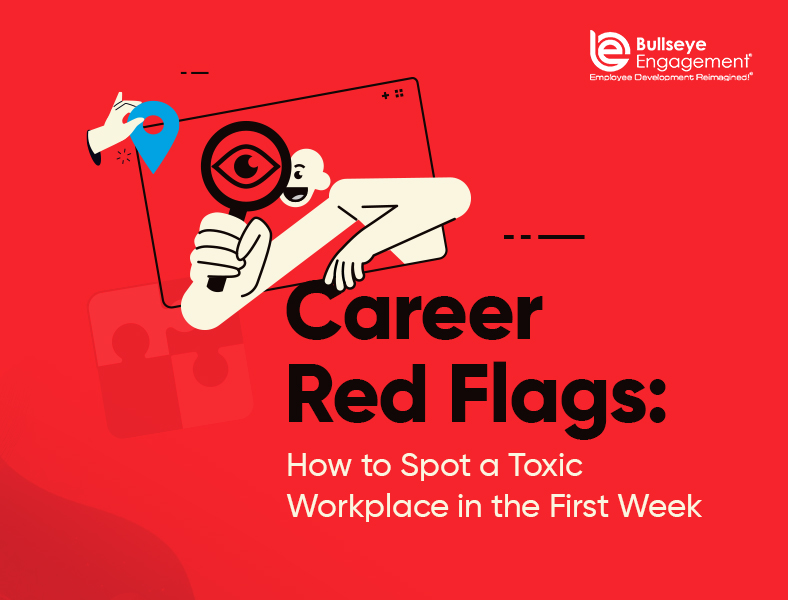Starting a new job is exciting, but it can also feel a bit like a gamble. Sometimes, everything seems perfect during the interviews—only for you to discover some serious red flags once you’re actually on the inside.
The good news? There are a few telltale signs that can help you figure out if a workplace is secretly toxic—before you get stuck. Here are some easy-to-spot red flags to watch out for in your first week—and what to do if you see them.
1. The Vanishing Manager
Red Flag: You barely see your manager after orientation, and they hardly respond to your messages.
Why It’s a Problem: Lack of communication can mean poor leadership or a chaotic work environment.
What to Do:
a) Be proactive: Ask to schedule a regular check-in to discuss your goals and progress.
b) Follow up politely: If they keep ghosting you, it’s a sign that support might be lacking.
2. Everyone Looks Exhausted (All the Time)
Red Flag: Your coworkers look drained, over-caffeinated, and constantly stressed out.
Why It’s a Problem: A team that always looks burned out is a clear sign of overwork and poor work-life balance.
What to Do:
a) Ask casually: “What’s a typical day like here?” If the answer involves lots of overtime, that’s a clue.
b) Watch for patterns: If everyone’s pulling late nights regularly, it’s a red flag.
3. The Secret Turnover Rate
Red Flag: When you ask about turnover, people dodge the question or change the subject.
Why It’s a Problem: High turnover usually means bad management, low morale, or a toxic culture.
What to Do:
a) Do some digging: Check LinkedIn to see how long past employees stayed.
b) Ask directly: “What’s the average tenure for this role?” Vague answers are a bad sign.
4. No Real Onboarding Plan
Red Flag: You get a quick hello, a bunch of passwords, and then you’re left to figure things out on your own.
Why It’s a Problem: Lack of proper onboarding means they might not invest in their employees.
What to Do:
a) Ask for resources: Request guides, documents, or a buddy to help you settle in.
b) Take notes: If no one helps, it might be a sign that things won’t improve.
5. Gossip Is Everywhere
Red Flag: By day two, you already know who hates the boss, who’s thinking of quitting, and which teams don’t get along.
Why It’s a Problem: A gossip-heavy culture often points to trust issues and poor communication.
What to Do:
a) Stay neutral: Listen but don’t join in.
b) Focus on facts: Ask questions about the job, not the drama.
6. Micromanagement Overload
Red Flag: Your manager wants to approve every email, double-checks every task, and constantly looks over your shoulder.
Why It’s a Problem: Micromanagement means lack of trust and autonomy.
What to Do:
a) Clarify boundaries: Ask what decisions you can make independently.
b) Suggest weekly updates: This might help reduce constant check-ins.
7. The Mission Is a Mystery
Red Flag: You ask about the company’s goals or mission and get a lot of buzzwords but no clear answers.
Why It’s a Problem: If leadership can’t explain the mission clearly, it might be because they don’t have one.
What to Do:
a)Ask specific questions: “What’s the top priority for this quarter?” can cut through the fluff.
b) Listen closely: If the answer feels empty, trust your gut.
8. Too Many Fancy Titles, Not Enough Clarity
Red Flag: The job titles sound cool—think “rockstar” or “ninja”—but the responsibilities are vague.
Why It’s a Problem: Trendy titles can hide the fact that you’ll be doing three people’s jobs.
What to Do:
a) Ask for specifics: Clarify your day-to-day tasks and priorities.
b) Look for growth: Ask about career paths and skills development.
9. Everything Is “Urgent”
Red Flag: Every task is labeled as high priority and needs to be done yesterday.
Why It’s a Problem: When everything is urgent, it usually means there’s poor planning or leadership.
What to Do:
a) Prioritize: Ask which tasks are actually the most important.
b) Push back gently: Suggest deadlines based on what’s realistic.
10. Avoiding Salary Talks
Red Flag: When you ask about salary growth, raises, or bonuses, you get vague answers like, “We’ll discuss that later.”
Why It’s a Problem: Avoiding money talks might mean they’re not planning to pay more—ever.
What to Do:
a) Ask directly: “How often are raises reviewed, and what’s the usual percentage?”
b) Get it in writing: If they make promises, ask for it to be included in your offer letter.
11. The 24/7 Email Culture
Red Flag: You get emails at odd hours and feel pressure to reply immediately—even outside of work hours.
Why It’s a Problem: An always-on culture is a fast track to burnout.
What to Do:
a) Set boundaries early: Mention your preferred working hours politely.
b) Turn off notifications: Make it clear you’ll respond during work hours only.
12. Lack of Praise or Recognition
Red Flag: Your manager or team never acknowledges hard work or achievements.
Why It’s a Problem: Lack of recognition can kill motivation and lead to burnout.
What to Do:
a) Speak up: Ask for feedback on your work directly.
b) Look for patterns: If no one gets recognized, it might not change anytime soon.
Trust Your Gut—And the Red Flags
No workplace is perfect, but if you start seeing these red flags during your first week, it might be time to think twice. A healthy work environment should leave you feeling motivated, supported, and excited to learn—not drained or confused.

















